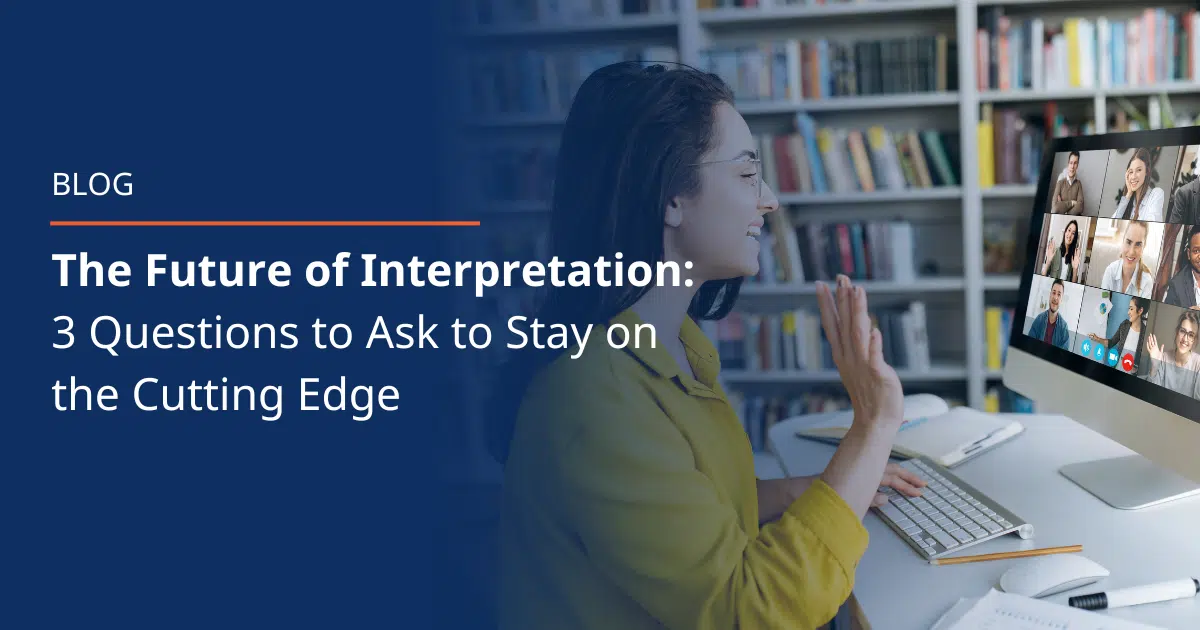In this day and age, our comfort with and desire for remote communication is stronger than ever before, creating new challenges and opportunities. One relevant example is from healthcare: the telemedicine market is expected to maintain a compound annual growth rate of 19.5% until 2030.
With this shift, companies must look ahead to ensure they’re providing consumers with the remote communication options they expect, including those with limited English proficiency (LEP). By 2050, 19% of Americans are expected to have LEP, more than doubling from 8% in 2020, and many of them will prefer to interact in their native language. Advancing interpretation technologies make it possible for organizations to provide these consumers with better experiences than ever before.
To keep up with this expected growth, we’ve noticed the following areas worth considering in your communications strategy: technology and software, remote options and artificial intelligence (AI). Here are three questions forward-thinking organizations must ask to make sure they are ready for the future of interpretation.
Question 1: Is my interpretation technology and software providing a good experience for LEP consumers?
Outdated technology means an outdated LEP experience. For example, in a multilingual contact center environment, outdated technology can cause interpretation related issues like poor call quality, delays, inconsistencies, inefficient call flows, inability to scale, and poor customer experience. Outdated technology can also impact compliance with language access regulations.
Updating your technology provides opportunities to address these issues and position your organization for success in the future. With updated, cloud-based call center technology, scaling interpretation is easier. Increased call volume is less of an obstacle, as callers benefit from faster connection times and better call quality even when volume is high. Today’s cutting-edge call center solutions also offer improved call routing, in-depth call analytics for more efficient workflows, and innovative options to ensure immediate connection to native speakers for callers returning voicemails.
Question 2: Am I providing the right mix of remote interpretation options?
Pandemic precautions encouraged the use of remote interpretation options like over-the-phone interpretation (OPI), video remote interpretation (VRI), and remote simultaneous interpretation (RSI). VRI skyrocketed in popularity as on-site interpreters switched to support VRI and businesses realized its value.
Each remote interpretation option has its own advantages and use cases, so offering the right mix of options for your LEP community’s needs is vital. In general:
- OPI is the most accessible and fastest option.
- VRI allows the interpreter to access nonverbal communication like body language and facial expressions for a better experience that is closer to on-site interpretation even when an on-site interpreter isn’t available. It’s excellent for American Sign Language (ASL) interpretation, as well.
- RSI is the best solution for a real-time consultation when multiple participants need to hear interpretation in their preferred language. The linguist interprets as participants speak, with no delay, for a more seamless experience.
Question 3: How will Artificial Intelligence (AI) impact the interpretation customer and interpreter experience?
AI is advancing at an astonishing pace and will have a profound impact on how businesses operate and communicate with customers, including interpretation. There’s no need to panic about being behind, but now is the time to familiarize yourself with the options available and start looking at the ways AI can benefit your business and your customers with LEP.
AI solutions have already been introduced to offer real-time interpretation for Zoom meetings on-the-fly, and AI speech-to-text options enhance IVR workflows for a better self-service experience. AI also has the potential to improve experiences for both customers with LEP and interpreters, by providing relevant context and guidance during live interactions.
Are you ready for the future of interpretation?
As we settle into our new normal, the way we use technology to communicate will continue to evolve. Technology, remote options, and AI will continue to advance to best serve the growing number of customers with LEP. By examining your current technologies and processes, keeping up to date on the latest advances in these technologies, and asking yourself these three questions, you’ll ensure the best possible experience for these customers both now and in the future.
Not sure where to go next? Chat with our team and our experts will help you chart the best path forward.








